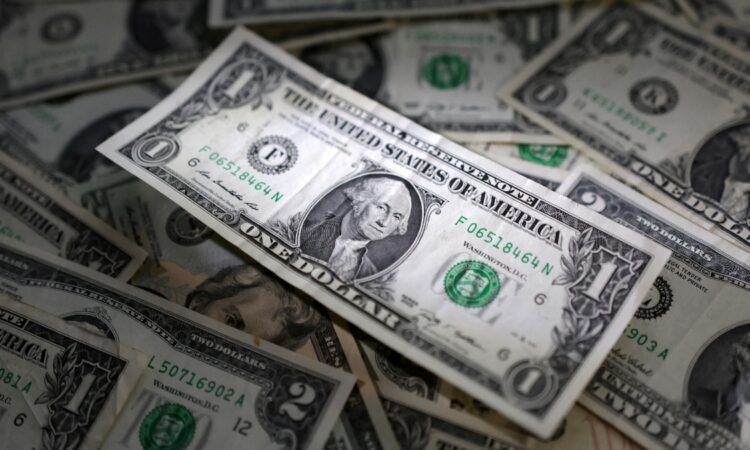
The deal signed on 8 June, 1974, allowed US dollars to be exchanged for crude oil exports. Reuters
The US-Saudi Arabia petrodollar deal has come to an end after five decades.
The deal that was signed on 8 June, 1974, allowed US dollars to be exchanged for crude oil exports.
It expired on 9 June, according to several media reports.
But what do we know about the deal? What happens next? And why has it been allowed to lapse?
Let’s take a closer look:
Petrodollars
First, let’s briefly look at petrodollars.
Petrodollars aren’t a currency.
Rather they are US dollars exchanged for crude oil exports.
According to Investopedia, the petrodollar system came about in the aftermath of the US going off the gold standard.
Until then, the US had tied its currency to the price of gold at $35 per ounce under the Bretton Woods Agreement
However, in 1971, then US president Richard M Nixon terminated the agreement.
This came after the US dollar collapsed after the global economy and its demand for safe assets exceeded the available supply of gold bullion.
The petrodollar system was set up the next year – in 1972.
Now, with global supply of dollars increasing, oil exporters earned more and more petrodollars thanks to higher oil prices.
They accepted dollars because there was simply no alternative.
What’s more, the dollar was the currency in which international trade and finance were carried out.
What the petrodollar system did was in effect reinforce the US dollar’s dominance as the global reserve currency.
This has had tangible benefits for Americans.
According to MSN, the use of dollars to purchase crude oil has assisted in keeping the currency strong.
This in turn has made imports comparatively cheap for US consumers.
The inflow of capital into US treasury bonds has given rise to low interest rates and a strong bond market.
The website quoted bestselling author and investment manager David Wright, in his book Bonfire of the Sanities wrote that people in the US enjoy “as high of a standard of living as we do is because the dollar is strong.”
Wright added this is also “because energy can’t be bought without US dollars.”
The deal
The deal between Saudi Arabia and the United States was struck in 1974.
According to Bloomberg, by then, an oil crisis had struck the US and prices had skyrocketed after sanctions from OPEC’s Arab nations in retaliation for Washington helping Israel during the Yom Kippur war.
The idea behind the deal was simple – the US would buy oil from the Kingdom and provide it with military aid and equipment.
Meanwhile, the Saudis would send billions of their petrodollar revenue back into America and finance its spending.
According to MSN, this was a win for both sides.
Washington would get a steady flow of oil and a market to buy its debt while the Kingdom would ensure its stability.
Experts say the US wasn’t alone in trying to get Saudi Arabia on side.
“Everyone — in the US, France, Britain, Japan — was trying to get their fingers in the Saudis’ pockets,” Gordon S Brown, an economic officer with the State Department at the US embassy in Riyadh from 1976 to 1978, told the outlet.
What happens now?
According to India Today, Saudi Arabia can now sell oil and receive yuan, Euros, rubles and yen.
It is also considering conducting transactions in digital currencies like Bitcoin.
In the long term, it might speed up the trend of using alternate currencies to settle international trade.
According to MSN, this could bring about a sea change in the global financial order.
“The petrodollar’s expiration could weaken the U.S. dollar and, by extension, the U.S. financial markets. If oil were to be priced in a currency other than the dollar, it could lead to a decline in global demand for the greenback. This, in turn, could result in higher inflation, higher interest rates, and a weaker bond market in the United States,” the website stated.
The website added that the development reflects a change in the undercurrents of global power.
“The US dollar’s dominance is no longer guaranteed,” it argued.
James E Thorne, of Wellington-Altus Financial Inc, wrote on X that the development represents a strategic move by the United States to facilitate a managed decline of the US dollar and enhance its ability to refinance its national debt at lower rates.
“This shift in global finance and geopolitics has far-reaching implications for fiscal dominance and the managed decline of the USD,” Thorne wrote.
“The shift away from the petrodollar system could contribute to a broader geopolitical realignment, with countries like Saudi Arabia seeking to reduce their reliance on the US and strengthen ties with other economic powers, such as China and the BRICS nations,” Thorne added.
With inputs from agencies
Find us on YouTube




